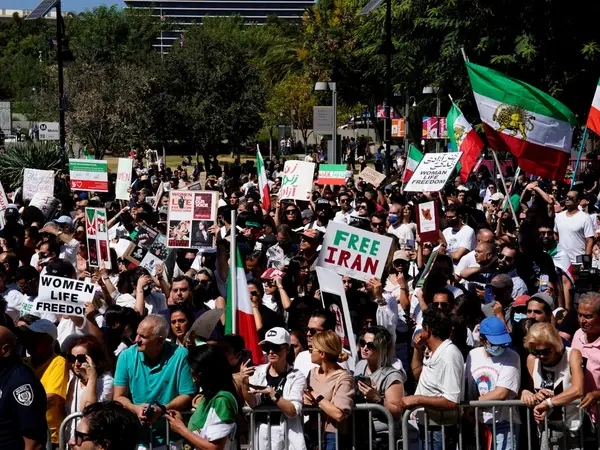The Islamic Republic’s parliament has finally convened to discuss and whitewash Mahsa Amini’s death in custody, and the ensuing protests by blaming “enemies.”
Although individual Iranian lawmakers had spoken about the ongoing uprising in Iran, the parliament (Majles) for the first time issued a statement on Saturday about what it called "recent insecurities", the busiest days of protests, as people and students took to the streets in the most widespread anti-government protests yet.
On Sunday, the Majles dominated by hard-line supporters of Supreme Leader Ali Khamenei convened to thank security forces for their public service during more than two weeks of protests. There are no reliable figures about how many protesters security forces have killed, but a rough number of 150 can be estimated, considering 42 killed on September 30 in Zahedan when government forces opened fire on demonstrators attacking police stations.
Lawmakers gathered on the floor of parliament and chanted "Death to seditionist" taking an agressive postion against the protesters, as seen in the video below tweeted by ISNA news agency..
The statement on Saturday showed that the lawmakers are determined to ignore the real causes of the protests and continue the regime’s policy of dismissing any criticism. This is what Supreme Leader Ali Khamenei has done throughout the years. This time he is completely silent raising questions if he is still functioning and in charge.
Blaming America and ‘enemies’
The Majles, sticking to religious rhetoric, condemned the protests and denounced what it called "recent insecurities, and insults to sanctities." It repeated unfounded accusations that protesters insulted Islam, while the only insult throughout the protests has been directed at Khamenei.
Nonetheless, the parliament promises to follow up the case of Mahsa Amini, the young woman who was murdered in police custody in mid-September. But by all indications, the Sunday session showed that the ruling hard-liners are looking for excuses to once again argue that her death might have been from natural causes.
Iran International had published Mahsa Amini’s CT scan showing a broken skull, that Fars news agency affiliated with the IRGC verified as genuine.
The statement on Saturday was not signed by individual members of the parliament, so, it is not known how many of the 290 Iranian MPs have signed this rather authoritarian statement. However, what is significant is that the parliament has acknowledged that it was the Amini’s death that triggered the anti-government protests.
The statement charged that a group of people who were not part of the protesters took advantage to create havoc and insecurity in Iran and called on the security forces to prosecute the culprits.
Meanwhile, Etemad Online website in Tehran has quoted IRGC Brigadier General Hassan Hassanzadeh who is in charge of Mohammad Rasoulallah Division, the largest IRGC unit, responsible for the capital’s security, as saying that "the IRGC has understood through eavesdropping that America is behind the protests and wishes to send Iranians to the streets to protest."
Hassanzadeh said, "America knows that it cannot secure a victory in Iran by furthering its ‘maximum pressure’ policy, so it tries to trigger protests in the streets of Tehran." He added, "They sent individuals to Iran. We have arrested some of them and are trying to identify the rest." However, he did not name anyone.
"In our eavesdropping, we found out two weeks ago that an American official said the US has concluded that they cannot win anything in Iran through pursuing the maximum pressure policy," Hassanzadeh said, adding that "The enemies sent groups of people into the streets and caused some damage." He added the enemies who were aware of the Iranian people's financial problems, tried to destabilize our Islamic system."
Khamenei silent
Hassanzadeh is the only IRGC commander who has commented so far about the current protests. Some of this silence is because military commanders and politicians are waiting for Khamenei to speak out, but he has not said a word about the protests that have galvanized Iranians and solicited many international reactions.
Some observers say Khamenei usually speaks about such events when he makes sure that his security forces have the upper hand in the streets and suppression is in its final stages.
Those who have spoken publicly about the ongoing events have either ranted the usual anti-US rhetoric which is part of the Islamic Republic jargon about any problem, or like the editor of hard-line Kayhan newspaper, have made outlandish remarks such as calling for the detention of movie stars and footballers to intimidate others.
While the protesters have made it clear that they no longer want to hear from or about Khamenei, his loyalists are anxiously looking forward to his next speech to get some ideas about how to react to the protests and what to say. If he does not show up soon, loyalists will have no choice other than concluding that there is something wrong about the 83-year-old ailing cleric.
